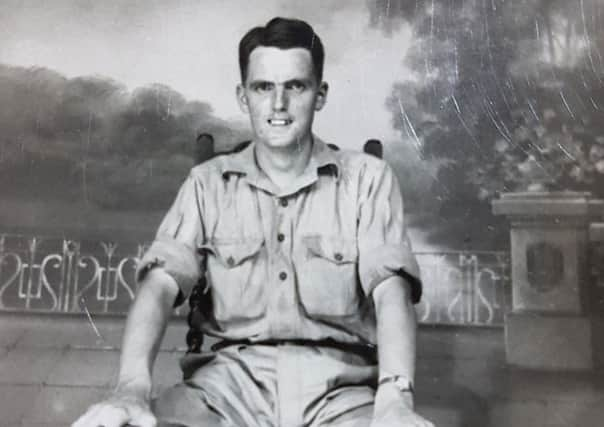Obituary: Harry Golding, engineer turned teacher who kept the RAF flying in India


Harry Golding was one of the vital ground crew who kept the RAF in the air over India during the Second World War.
As a young apprentice engineer in Aberdeen he was called up to use his skills maintaining the Rolls Royce Merlin engines that powered the Hurricanes, Spitfires and Wellington bombers that took to the skies to keep the Japanese at bay.
Advertisement
Hide AdAdvertisement
Hide AdThat experience and his love of railways made him an enthusiastic transport expert, with an encyclopaedic knowledge of machines from warplanes to trains and trams.
Glasgow-born, to a locomotive engineer father, he was raised from infancy in Aberdeen city centre where his first memory of trains was as they sped past Union Terrace Gardens where he played.
Educated at Aberdeen Grammar School, where his mother was a cleaner, his trainspotting continued throughout his schooldays in the 1930s when he and his friends befriended the signalman in the Aberdeen signal box.
By this time his mother had been widowed and life was not easy for the family who lived in a basement flat with no electricity or running hot water. But as a choirboy at St John’s Church, he earned £1 a month – cash that supplemented his mother’s wages.
With no prospect of funding a university place, at 16 he secured an apprenticeship as a mechanical engineer at the city’s biggest engineering works, John M Henderson, but he was unable to finish it before his call up papers for the RAF arrived in 1941.
“That’s when the bottom fell out of my life,” he observed drily more than 70 years later.Working in a reserved occupation, he had not expected to be conscripted but the RAF’s need for more men with an engineering background saw him selected for service and training in Wales, Yorkshire and Northumberland.
The young aircraftsman subsequently sailed for India on the Mooltan, a former liner requisitioned as a troopship, a voyage that took in Sierra Leone, Durban and Bombay. He was then posted to Golden Rock Trichonopoly, a railway workshop used for the repair of RAF planes.
By June 1943 he had been promoted to leading aircraftsman but soon afterwards contracted malaria and was sent to a medical clearing station in Bangalore. Once recovered, he returned to Golden Rock where he worked until 1944.
Advertisement
Hide AdAdvertisement
Hide AdFrom there he went to RAF Cawnpore No 3 Civilian Maintenance Unit, near the banks of the Ganges, and then to Lucknow, both in Uttar Pradesh.
During his service he worked on various aircraft and engines including the famous Merlin engines, and on Hurricanes, Beauforts, Moths, Wellingtons, Hudson MkIIIs, Dakotas and Expeditors.
He was in a team refurbishing the huge V12 engines every 300 flying hours, completely rebuilding them and becoming an expert on the supercharger used to boost power.
It was a life of hardship, intense pressure, danger and fatigue. An aircraftman’s days were long and difficult, especially in the searing heat of India, and required enormous attention to detail. A heavy weight of responsibility rested on them as great numbers of airman depended upon the skilled mechanics to enable them to do their job safely and efficiently in the skies.
Returning to Aberdeen after being demobbed in 1946, he went back to finish his apprenticeship at Hendersons and admitted that fitting back into civilian life and having a normal conversation could be awkward.
He said: “The people in Aberdeen didn’t know what you had been doing and you didn’t know what had been going on in Aberdeen for three-and-a-half years.”
He also worked for engineering firms Beldam and Tawse but after being made redundant in 1961, decided to retrain and studied at commercial college to gain the necessary qualifications to go to university. After becoming a mature student at Aberdeen University in 1963, he wenton to teacher training college and spent his teaching career at Aberdeen Technical College where he taught English and general studies until retiring in 1988.
Meanwhile he maintained his interest in transport – railways in particular and everything relating to them. He was a member of the Great North of Scotland Railway Association and had been one of those on board the last passenger train on Speyside in 1968. He was also involved in the Aberdeen Transport Society and established the Aberdeen Tram Rosette Appreciation Society in 1994.
Advertisement
Hide AdAdvertisement
Hide AdLast year, after more than seven decades, all his wartime memories came flooding back when, on a visit to Grampian Transport Museum at Alford, he was astonished to see a Rolls Royce Merlin engine. Owned by television presenter, author motorbike race and truck mechanic, Guy Martin, it transported him back to his time in India and he was instantly familiar with all the various parts.
Predeceased by his wife Elaine, whom he married in 1954, he is survived by their daughter Helen and grandsons Sean and Jordan.
ALISON SHAW